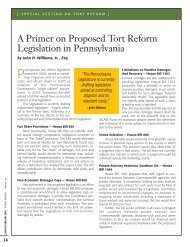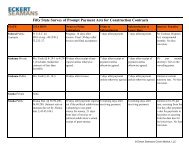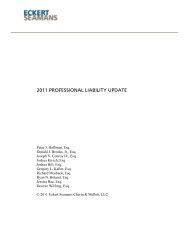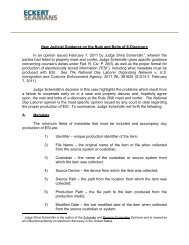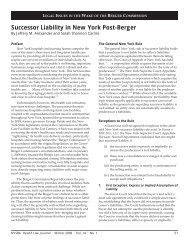2012 PROFESSIONAL LIABILITY UPDATE - Eckert Seamans
2012 PROFESSIONAL LIABILITY UPDATE - Eckert Seamans
2012 PROFESSIONAL LIABILITY UPDATE - Eckert Seamans
Create successful ePaper yourself
Turn your PDF publications into a flip-book with our unique Google optimized e-Paper software.
unit to assure post-surgical patients are not discharged with post-operativelife threatening complications.Id. (internal citations and quotations omitted). The court found that the allegations fit within thefour (4) Thompson duties. Additionally, the court held that the plaintiffs provided sufficientfactual support to proceed with this claim. Id. Interestingly, the court noted, “[t]o the extent thatthe Complaint does not contain more specific factual allegations concerning the actual policiesand procedures and any language therein, this is because Defendant, not Plaintiffs, is inpossession of, and knowledgeable about, such policies.” Id. at *3. Based on the facts as pled,the court found it “plausible” that the defendant hospital’s policies and procedures wereresponsible for the decedent’s death. Id. Accordingly, the court denied the defendant’s motion.In Scampone v. Grane Healthcare Co., 2010 WL 2780315 (Pa. Super. July 15, 2010),appeal granted, 15 A.3d 427 (Pa. 2011), the court upheld an extension of corporate liabilitybeyond hospitals and against a nursing home facility, Highland Park Care Center, and thecorporation managing the nursing home, Grane Healthcare Company. In this medicalmalpractice action, the plaintiff alleged that his decedent received substandard care andtreatment, causing the decedent’s decline in health and death. Id. at *1. Among the variousclaims, the plaintiff set forth a claim for corporate liability “premised upon the existence ofchronic understaffing at the facility such that the employees were incapable of performingappropriate care to the nursing home residents, including [his decedent].” Id. Following trial,the jury concluded that the defendant nursing home was liable under theories of corporate andvicarious liability. Id. at *2. The nursing home appealed. In the appeal, it argued, inter alia,that (1) corporate liability is limited to hospitals and HMOs, not nursing homes, (2) corporatenegligence cannot be premised upon allegations of “understaffing”, and (3) expert testimony isrequired to prove breach and causation. Id. at *3.In addressing the types of entities which may be held liable under a theory of corporateliability, the court stated that it has previously extended liability to HMOs and medicalprofessional corporations which are responsible for coordination of the plaintiff’s care and which“[assume] responsibility for the coordination and management of all patients.” Id. at *5. In theinstant case, the court heldthat a nursing home is analogous to a hospital in the level of itsinvolvement in a patient’s overall health care. Except for the hiring ofdoctors, a nursing home provides comprehensive and continual physicalcare for its patients. A nursing home is akin to a hospital rather than aphysician’s office, and the doctrine of corporate liability was appropriatelyapplied in this case.Id. at *6. Likewise, the court concluded that the corporation managing the nursing home is alsosubject to corporate liability for understaffing. Id. at *21. The court noted that the managementcorporation exercised complete control over all aspects of the nursing home’s operation. Id.Essentially, the management corporation had assumed the responsibility of a comprehensivehealth center, arranging and coordinating the total health care of the nursing facility residents.Specifically,66




